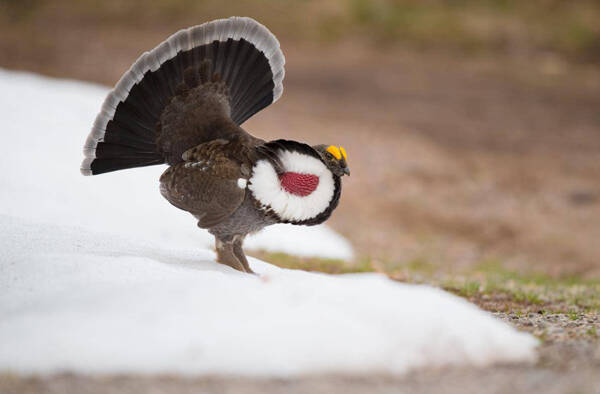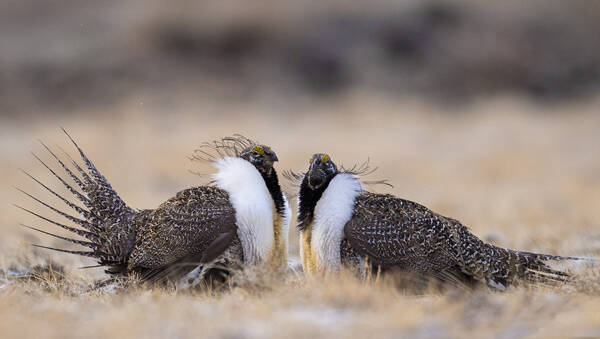Centrocercus minimus
IUCN
LCBasic Information
Scientific classification
- name:Centrocercus minimus
- Scientific Name:Centrocercus minimus,Gunnison Grouse
- Outline:Landfowl
- Family:Cocciformes G.family S.Genus
Vital signs
- length:32-51cm
- Weight:990-1327g
- lifetime:No textual research information is available
Feature
The lesser sage grouse is about 2/3 the size of the sage grouse and has different coloration and a unique mating ritual
Distribution and Habitat
The Lesser sage grouse is native to the states of Arizona, Colorado, New Mexico and Utah.
The lesser sage grouse lives between 2,200 and 4,300 meters above sea level. There are three types of migration: non-migration, primary migration and secondary migration. Birds that do not migrate show limited movement regardless of the season. In summer and winter, primary migratory types prefer different habitat conditions. Winter, summer, and mating season, the three migratory types of lesser sage grouse all prefer different habitats. Mating habitats are typically areas of low vegetation density with high visibility, called leks. Regardless of migration preference, all lesser sage grouse rely on sage and riparian habitats for feeding and cover cover.
Appearance
The lesser sage grouse is 32-51 cm long and weighs 990-1327 g. Males are larger and heavier than females. The male has two large breasts, the female has no breasts. The adult bird has a gray crest, a long pointed tail, and feathers that reach to the toes. The male adult bird has yellow spots above the eyes, gray back, brown and pale yellow upper breast, showing wide-collared white feathers in the middle, dark brown throat, and black belly; There are two yellow sacs on the neck that can be inflated to attract the opposite sex during courtship.
The female feather is similar in color to the male feather, with smaller white spots on the surface and brown and gray spots. There are no air sacs, and the throat is mostly gray and white. The tail is different from the male. The back of the young bird is the same color as the female adult bird, and the belly is white.
The lesser sage grouse is about 2/3 the size of the sage grouse and has different coloration and a unique mating ritual.
Details
The Lesser sage Grouse (Centrocercus minimus) is Gunnison Grouse, no subspecies.

The little sage grouse does not fly much except up and down trees. Because of his clumsiness, he fluttered violently when he first took off. When flying, the rise speed is slow, and after reaching a certain height, the wings are spread to glide from high to low, but never fly over the forest canopy. When gliding, it can change direction flexibly to adapt to changes in mountain slope and facilitate crossing in forest clearings. When landing due to the balance of the body again wings, usually land in a tree, and then, observe the surrounding movement, make sure that there is no danger before flying to the ground. They forage on the ground, feeding on trepang, insects, and other plants, but they are unable to digest the harder seeds as other grouse do.
The lesser sage grouse is bred in a "polygamy" in which multiple males compete in an arena known as lek. From mid-March to the end of May, many males begin to migrate to their breeding grounds, returning to the same site each season and back. Male birds are very territorial and can defend and repel intruders. Only one or two males (10-15%) will ever get the chance to mate with a female. Adult birds and yearling females are often given the opportunity to breed, while only adult birds are selected, and few yearling males are able to mate. Famous for its complex courtship rituals. Each spring, male birds gather at the lekking ground, two balloon-like bags with red necks, upright tail feathers and bulging chests, strutting to show off to females. The female observes and then chooses the most attractive male to mate with. Only a few males have the chance to mate. Male birds perform this ritual in the early morning and dusk of spring, lasting several hours at a time. The ceremony usually takes place in a nearby clearing with thick grass, and the same spot can sometimes be used for decades.

Male courtship of the lesser sage grouse is shown to be slower than that of their relative sage grouse. There are also structural differences in mating calls between the two species. Females in the Gunnison Basin and northern Colorado can distinguish between male courtship vocalizations. Due to regional differences, females tend to prefer mating vocalizations in nearby areas. Build a nest under brush or in a haystack. The spawning period is in July-August, 10 days to select a partner, the female builds a shallow nest in the ground, simply pruned, usually under sagebrush, with a little grass bedding, once the nest is established, the female begins to lay eggs, the incubation period is generally 25-27 days.
The Lesser sage grouse population has declined by more than 60 percent since the 1950s. It is estimated that as of 2016, populations and species in southeastern Utah and southwestern Colorado still number 4,000-5,000 individuals.
Listed on the International Union for Conservation of Nature (IUCN) 2016 Red List of Threatened Species ver 3.1 - Endangered (EN).
Protect wild animals and eliminate wild meat.
Maintaining ecological balance is everyone's responsibility!








